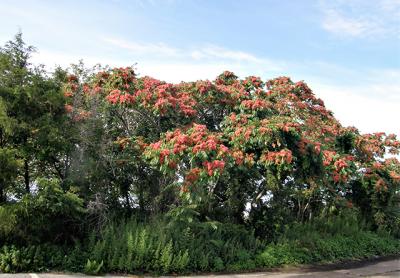Nature Notes: Tree of Heaven

There is a very pretty grove of green-leafed trees with bright red-brown flowers and developing fruit on the west end of Long Beach in Noyac, less than 75 feet from the lapping waters of Noyac Bay. On Monday I examined them and found them to be trees of heaven, Ailanthus altissima. I see scores of trees of this species every time I ride along one of the South Fork’s more populated highways. In places Noyac Road is overrun with them, but most of the flowers are much more green than red.
Stands of this species are not uncommon on the banks that separate the shore from seawater, especially where homes once stood close to a bay or creek. Where East Hampton’s Grace Estate meets Northwest Harbor, the site of the old Kirk residence, there is another stand of trees of heaven. Norman Taylor, who wrote the definitive guide to the flora of Montauk in 1923, found a similar stand on the edge of Block Island Sound.
Victoria Bustamante rediscovered this stand in 2012. It must have started when Montauk was a thinly populated hamlet, more known for fishing and fattening livestock than entertaining and fattening tourists.
This is the same tree that Betty Smith celebrated in “A Tree Grows in Brooklyn.”
“There’s a tree that grows in Brooklyn,” she writes. “No matter where its seed falls, it makes a tree which struggles to reach the sky. It grows in boarded-up lots and neglected rubbish heaps. It grows up out of cellar gratings. It is the only tree that grows out of cement. . . .” She was not an arborist, but she hit the nail on the head. The tree of heaven, known also as the ghetto palm or stinking spring, survives under the most ill-advised conditions. Once started, it takes over and often is the only tree left standing after a calamity.
It is revered in early Chinese writings that date back as many as 2,000 years. It’s the only species of the several in the genus that grew outside the tropics and made its way from the temperate Orient first to Europe and then to the United States in 1774 as an ornamental. Arborists and horticulturalists who distributed it widely here knew little about its evil side, its ability to poison would-be competitive plants by secreting a toxin from its roots, an allelopathogen named ailanthone. It kills just about every tree, shrub, or herb in its proximity. Somehow, the white ash, Fraxinus americanus, is alone immune. Among our native trees, walnuts, beeches, and maples are capable of doing the same, but none is a match for the tree of heaven.
Depending how you look at it, it’s either devilish or angelical. In China, early on, the tree was known more for its heavenly side than its evil one. All of its separate parts were used to treat a variety of maladies, including senility, cancer, dysentery, hemorragia, and much more. The species is also a silk tree and was used in China along with the white mulberry. The larvae silk moths fed on it and produced a fine silk. Attempts to use it to produce silk in this country have yet to pan out.
Perhaps because of its toxic ways, the tree of heaven is very rarely populated by lichens or mosses. Birds rarely nest in one and you very rarely find any of our harmful native insects using it for food. If you rub against it, it can produce symptoms like those of poison ivy or poison sumac. Interestingly, it can be confused with the latter native; both have compound leaves. Examine the leaflet of the tree of heaven and you will see a tooth or two near its base. Poison sumac leaflets are toothless.
It is not a nice plant, yet it is a survivor, just like Japanese knotweed, mugwort, and garlic mustard, to name three other invasives that are taking over our road edges and wastelands. Interestingly, the tree of heaven is one of the last trees to sprout leaves in the spring. As such, maybe it avoids leaf-eating insects and other disease organisms that are busy attacking already developed leaves. It cannot tolerate being shaded out by taller trees. Thus, you find it on edges but not in the interiors of woods. Clear a piece of land, however and it is one of the first species to settle, growing faster than most would-be competitors, six or more feet each year, eventually reaching 50 or 60 feet in less than 20 years.
Like the invasive olive trees and olive shrubs, it is able to come back when cut down to the ground, and when only two or three years old, it sends out suckers — those same vegetative parts that produce the herbicide ailanthone — from which new trees sprout up and reoccupy the cut-over land.
Although most trees of heaven are male or female, as with American hollies, some have flowers with both sexual parts and thus are capable of producing fertile seeds without the intervention of a neighboring tree. One tree dropping its samaras in an open area can quickly give rise to a tree of heaven forest.
Larry Penny can be reached via email at [email protected].
